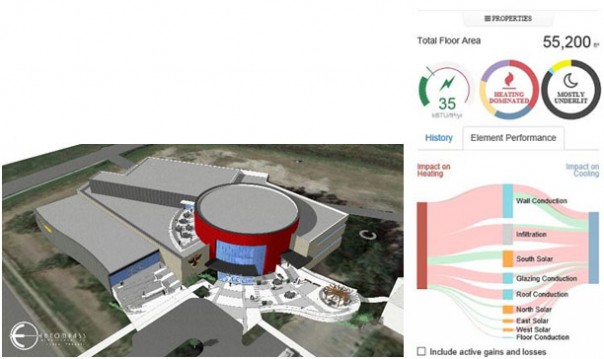Architects are well aware that designs have a significant impact on the environment. Understanding that impact with analytical data has been a challenge. Building performance is complex and the tools and information required to make informed, timely decisions has typically not been readily available. Architects have relied on rules of thumb, industry standards, rudimentary analysis and calculations, and prescriptive requirements to attempt to achieve “green design.” Although well intentioned, these methods often fall well short of significantly improving building performance.
Residential and commercial buildings account for over 30% of the total energy and 70% of all electricity consumed in the United States. The requirements for improving on building performance and efficiency are becoming stricter and will require a shift in the paradigm for how projects are delivered in the future. The rules of thumb and prescriptive methods of green design will simply not be adequate to achieve these greater performance standards. Typically building performance is analyzed by the engineers in a process somewhat isolated from the architects and occurring after the design is essentially complete. Feedback to the architect is limited and provided too late in the process to have meaningful effect on the design. Earlier analytics in the design process is becoming necessary to achieve the higher performance standards required.
The advent of Building Information Modeling (BIM) in the design industry approximately a decade ago has continued to transform the entire design process. What started as a platform to allow for greater coordination, consistency, and visualization has evolved into a platform that provides levels of information far beyond what was previously available. This evolution now includes building performance analysis tools for the architect. Models and design concepts generated very early in the process can be analyzed for their performance and efficiency. Feedback is immediate and the data can be used as a basis for decision making.
Virtually all aspects of the building envelope can be evaluated and optimized for maximum efficiency, including: building orientation; thermal values of walls, roofs, and openings; glazing types and amounts; shading devices; day lighting effectiveness, etc. The goal is to maximize the efficiency of the building envelope and minimize the energy load on the building. The following outlines some of the design data that can be generated from performance modeling.
The above image on the left shows a preliminary BIM model developed as part of the conceptual design phase to illustrate the design intent with the client. The model was used to evaluate the performance of the design. The preliminary modeling information uses ASHRAE 90.1 2010 for its baseline envelope data to eliminate cumbersome data entry and provide a consistent basis for comparative analysis of different design solutions. The modeling above indicates the design is heating-dominated and indicates the impact of the building elements on the heating and cooling loads. In this case wall construction and infiltration are the two primary factors affecting the heating load. The modeling also indicates that average energy performance of the design is 35 kBTU/sq.ft./year and the building is underlit from a daylighting strategy.
The initial modeling data can be analyzed in further detail providing additional information on the most effective strategies for reducing the energy load of the building. The graph above models the energy use by month, type of energy used and for what. Again, space heating is indicated as the primary energy need and suggests the most effective strategies are those which would reduce the heating load.
The performance modeling can also evaluate specific aspects of the building envelope and optimize their impact on energy use. The graph on the left analyzes the roof R-value and its impact on heating and cooling load. The model indicates for the conceptual design, the roof R-value achieves most of its efficiency at approximately an R of 18-20, with only marginal improvements in the performance beyond that value. Prescriptive code requirements of R-30 plus in this area indicate that money spent on roof insulation may be better spent on other aspects to truly impact energy efficiency. The graph on the right analyzes the optimum building orientation on the site. The current orientation – indicated by the blue dot – is actually the least desirable from and efficiency standpoint. Rotating the building 100 degrees clockwise maximizes the building orientation impact on the energy efficiency but the actual savings is marginal as indicated on the annual energy consumption amounts indicated on the left side of the graph.
The diagrams above are generated from day lighting simulations for the ground and second floors (left and right respectively). The simulation indicates that the preliminary design is underlit and that additional strategies would need to be implemented for day lighting to be an effective green design strategy. The simulation does provide critical data on the general areas which are underlit as well as the amount of daylight reaching the various areas of the design.
The above provides a sample of the modeling data, the components that can be evaluated, and the ability of conceptual performance modeling to significantly impact the way in which architects deliver design. Similar to how BIM transformed the design process, performance-based design will improve the decision making process during design by allowing it to be based on evaluation and data rather than rules of thumb or prescriptive requirements.
These modeling tools will allow the Architect to incorporate building performance as an integral component of the design process. Building efficiency will be increased resulting in reduced operating and life-cycle costs. Initial construction cost can be decreased by downsizing of equipment and eliminating of unnecessary elements not contributing to the building performance. Most importantly, the owners and building users will be the primary beneficiaries of the improved designs; and the built environment’s impact on the environment will be improved.




